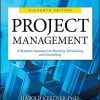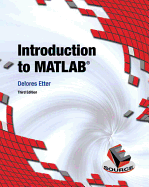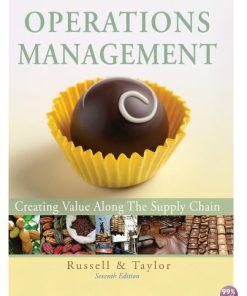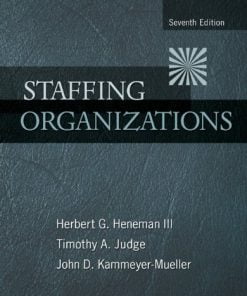Database Systems A Practical Approach to Design Implementation and Management 6th Edition Connolly Solutions Manual
$35.00 Original price was: $35.00.$26.50Current price is: $26.50.
Database Systems A Practical Approach to Design Implementation and Management 6th Edition Connolly Solutions Manual
Instant download Database Systems A Practical Approach to Design Implementation and Management 6th Edition Connolly Solutions Manual pdf docx epub after payment.
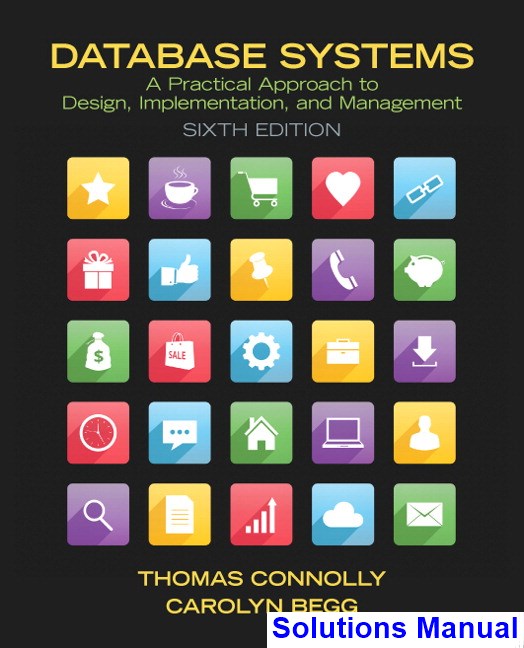
Product details:
- ISBN-10 : 0132943263
- ISBN-13 : 978-0132943260
- Author: Thomas M. Connolly; Carolyn E. Begg
Database Systems is ideal for a one- or two-term course in database management or database design in an undergraduate or graduate level course. With its comprehensive coverage, this book can also be used as a reference for IT professionals.
This best-selling text introduces the theory behind databases in a concise yet comprehensive manner, providing database design methodology that can be used by both technical and non-technical readers. The methodology for relational Database Management Systems is presented in simple, step-by-step instructions in conjunction with a realistic worked example using three explicit phases―conceptual, logical, and physical database design.
Table of contents:
- Chapter 1 Introduction to Databases
- 1.1 Introduction
- 1.2 Traditional File-Based Systems
- 1.2.1 File-Based Approach
- 1.2.2 Limitations of the File-Based Approach
- 1.3 Database Approach
- 1.3.1 The Database
- 1.3.2 The Database Management System (DBMS)
- 1.3.3 (Database) Application Programs
- 1.3.4 Components of the DBMS Environment
- 1.3.5 Database Design: The Paradigm Shift
- 1.4 Roles in the Database Environment
- 1.4.1 Data and Database Administrators
- 1.4.2 Database Designers
- 1.4.3 Application Developers
- 1.4.4 End-Users
- 1.5 History of Database Management Systems
- 1.6 Advantages and Disadvantages of DBMSs
- Chapter Summary
- Review Questions
- Exercises
- Chapter 2 Database Environment
- 2.1 The Three-Level ANSI-SPARC Architecture
- 2.1.1 External Level
- 2.1.2 Conceptual Level
- 2.1.3 Internal Level
- 2.1.4 Schemas, Mappings, and Instances
- 2.1.5 Data Independence
- 2.2 Database Languages
- 2.2.1 The Data Definition Language (DDL)
- 2.2.2 The Data Manipulation Language (DML)
- 2.2.3 Fourth-Generation Languages (4GLs)
- 2.3 Data Models and Conceptual Modeling
- 2.3.1 Object-Based Data Models
- 2.3.2 Record-Based Data Models
- 2.3.3 Physical Data Models
- 2.3.4 Conceptual Modeling
- 2.4 Functions of a DBMS
- Chapter Summary
- Review Questions
- Exercises
- 2.1 The Three-Level ANSI-SPARC Architecture
- Chapter 3 Database Architectures and the Web
- 3.1 Multi-user DBMS Architectures
- 3.1.1 Teleprocessing
- 3.1.2 File-Server Architecture
- 3.1.3 Traditional Two-Tier Client—Server Architecture
- 3.1.4 Three-Tier Client—Server Architecture
- 3.1.5 N-Tier Architectures
- 3.1.6 Middleware
- 3.1.7 Transaction Processing Monitors
- 3.2 Web Services and Service-Oriented Architectures
- 3.2.1 Web Services
- 3.2.2 Service-Oriented Architectures (SOA)
- 3.3 Distributed DBMSs
- 3.4 Data Warehousing
- 3.5 Cloud Computing
- 3.5.1 Benefits and Risks of Cloud Computing
- 3.5.2 Cloud-based database solutions
- 3.6 Components of a DBMS
- 3.7 Oracle Architecture
- 3.7.1 Oracle’s Logical Database Structure
- 3.7.2 Oracle’s Physical Database Structure
- Chapter Summary
- Review Questions
- Exercises
Part 2 The Relational Model and Languages
- Chapter 4 The Relational Model
- 4.1 Brief History of the Relational Model
- 4.2 Terminology
- 4.2.1 Relational Data Structure
- 4.2.2 Mathematical Relations
- 4.2.3 Database Relations
- 4.2.4 Properties of Relations
- 4.2.5 Relational Keys
- 4.2.6 Representing Relational Database Schemas
- 4.3 Integrity Constraints
- 4.3.1 Nulls
- 4.3.2 Entity Integrity
- 4.3.3 Referential Integrity
- 4.3.4 General Constraints
- 4.4 Views
- 4.4.1 Terminology
- 4.4.2 Purpose of Views
- 4.4.3 Updating Views
- Chapter Summary
- Review Questions
- Exercises
- Chapter 5 Relational Algebra and Relational Calculus
- 5.1 The Relational Algebra
- 5.1.1 Unary Operations
- 5.1.2 Set Operations
- 5.1.3 Join Operations
- 5.1.4 Division Operation
- 5.1.5 Aggregation and Grouping Operations
- 5.1.6 Summary of the Relational Algebra Operations
- 5.2 The Relational Calculus
- 5.2.1 Tuple Relational Calculus
- 5.2.2 Domain Relational Calculus
- 5.3 Other Languages
- Chapter Summary
- Review Questions
- Exercises
- 5.1 The Relational Algebra
- 3.1 Multi-user DBMS Architectures
- Chapter 6 SQL: Data Manipulation
- 6.1 Introduction to SQL
- 6.1.1 Objectives of SQL
- 6.1.2 History of SQL
- 6.1.3 Importance of SQL
- 6.1.4 Terminology
- 6.2 Writing SQL Commands
- 6.3 Data Manipulation
- 6.3.1 Simple Queries
- 6.3.2 Sorting Results (ORDER BY Clause)
- 6.3.3 Using the SQL Aggregate Functions
- 6.3.4 Grouping Results (GROUP BY Clause)
- 6.3.5 Subqueries
- 6.3.6 ANY and ALL
- 6.3.7 Multi-table Queries
- 6.3.8 EXISTS and NOT EXISTS
- 6.3.9 Combining Result Tables (UNION, INTERSECT, EXCEPT)
- 6.3.10 Database Updates
- Chapter Summary
- Review Questions
- Exercises
- 6.1 Introduction to SQL
- Chapter 7 SQL: Data Definition
- 7.1 The ISO SQL Data Types
- 7.1.1 SQL Identifiers
- 7.1.2 SQL Scalar Data Types
- 7.2 Integrity Enhancement Feature
- 7.2.1 Required Data
- 7.2.2 Domain Constraints
- 7.2.3 Entity Integrity
- 7.2.4 Referential Integrity
- 7.2.5 General Constraints
- 7.3 Data Definition
- 7.3.1 Creating a Database
- 7.3.2 Creating a Table (CREATE TABLE)
- 7.3.3 Changing a Table Definition (ALTER TABLE)
- 7.3.4 Removing a Table (DROP TABLE)
- 7.3.5 Creating an Index (CREATE INDEX)
- 7.3.6 Removing an Index (DROP INDEX)
- 7.4 Views
- 7.4.1 Creating a View (CREATE VIEW)
- 7.4.2 Removing a View (DROP VIEW)
- 7.4.3 View Resolution
- 7.4.4 Restrictions on Views
- 7.4.5 View Updatability
- 7.4.6 WITH CHECK OPTION
- 7.4.7 Advantages and Disadvantages of Views
- 7.4.8 View Materialization
- 7.5 Transactions
- 7.5.1 Immediate and Deferred Integrity Constraints
- 7.6 Discretionary Access Control
- 7.6.1 Granting Privileges to Other Users (GRANT)
- 7.6.2 Revoking Privileges from Users (REVOKE)
- Chapter Summary
- Review Questions
- Exercises
- 7.1 The ISO SQL Data Types
- Chapter 8 Advanced SQL
- 8.1 The SQL Programming Language
- 8.1.1 Declarations
- 8.1.2 Assignments
- 8.1.3 Control Statements
- 8.1.4 Exceptions in PL/SQL
- 8.1.5 Cursors in PL/SQL
- 8.2 Subprograms, Stored Procedures, Functions, and Packages
- 8.3 Triggers
- 8.4 Recursion
- Chapter Summary
- Review Questions
- Exercises
- 8.1 The SQL Programming Language
- Chapter 9 Object-Relational DBMSs
- 9.1 Advanced Database Applications
- 9.2 Weaknesses of RDBMSs
- 9.3 Storing Objects in a Relational Database
- 9.3.1 Mapping Classes to Relations
- 9.3.2 Accessing Objects in the Relational Database
- 9.4 Introduction to Object-Relational Database Systems
- 9.5 SQL:2011
- 9.5.1 Row Types
- 9.5.2 User-Defined Types
- 9.5.3 Subtypes and Supertypes
- 9.5.4 User-Defined Routines
- 9.5.5 Polymorphism
- 9.5.6 Reference Types and Object Identity
- 9.5.7 Creating Tables
- 9.5.8 Querying Data
- 9.5.9 Collection Types
- 9.5.10 Typed Views
- 9.5.11 Persistent Stored Modules
- 9.5.12 Triggers
- 9.5.13 Large Objects
- 9.5.14 Recursion
- 9.6 Object-Oriented Extensions in Oracle
- 9.6.1 User-Defined Data Types
- 9.6.2 Manipulating Object Tables
- 9.6.3 Object Views
- 9.6.4 Privileges
- Chapter Summary
- Review Questions
- Exercises
Part 3 Database Analysis and Design
- Chapter 10 Database System Development Lifecycle
- 10.1 The Information Systems Lifecycle
- 10.2 The Database System Development Lifecycle
- 10.3 Database Planning
- 10.4 System Definition
- 10.4.1 User Views
- 10.5 Requirements Collection and Analysis
- 10.5.1 Centralized Approach
- 10.5.2 View Integration Approach
- 10.6 Database Design
- 10.6.1 Approaches to Database Design
- 10.6.2 Data Modeling
- 10.6.3 Phases of Database Design
- 10.7 DBMS Selection
- 10.7.1 Selecting the DBMS
- 10.8 Application Design
- 10.8.1 Transaction Design
- 10.8.2 User Interface Design Guidelines
- 10.9 Prototyping
- 10.10 Implementation
- 10.11 Data Conversion and Loading
- 10.12 Testing
- 10.13 Operational Maintenance
- 10.14 CASE Tools
- Chapter Summary
- Review Questions
- Exercises
- Chapter 11 Database Analysis and the DreamHome Case Study
- 11.1 When Are Fact-Finding Techniques Used?
- 11.2 What Facts Are Collected?
- 11.3 Fact-Finding Techniques
- 11.3.1 Examining Documentation
- 11.3.2 Interviewing
- 11.3.3 Observing the Enterprise in Operation
- 11.3.4 Research
- 11.3.5 Questionnaires
- 11.4 Using Fact-Finding Techniques: A Worked -Example
- 11.4.1 The DreamHome Case Study–An Overview of the Current System
- 11.4.2 The DreamHome Case Study–Database Planning
- 11.4.3 The DreamHome Case Study–System Definition
- 11.4.4 The DreamHome Case Study–Requirements Collection and Analysis
- 11.4.5 The DreamHome Case Study–Database Design
- Chapter Summary
- Review Questions
- Exercises
- Chapter 12 Entity—Relationship Modeling
- 12.1 Entity Types
- 12.2 Relationship Types
- 12.2.1 Degree of Relationship Type
- 12.2.2 Recursive Relationship
- 12.3 Attributes
- 12.3.1 Simple and Composite Attributes
- 12.3.2 Single-valued and Multi-valued Attributes
- 12.3.3 Derived Attributes
- 12.3.4 Keys
- 12.4 Strong and Weak Entity Types
- 12.5 Attributes on Relationships
- 12.6 Structural Constraints
- 12.6.1 One-to-One (1:1) Relationships
- 12.6.2 One-to-Many (1:*) Relationships
- 12.6.3 Many-to-Many (*:*) Relationships
- 12.6.4 Multiplicity for Complex Relationships
- 12.6.5 Cardinality and Participation Constraints
- 12.7 Problems with ER Models
- 12.7.1 Fan Traps
- 12.7.2 Chasm Traps
- Chapter Summary
- Review Questions
- Exercises
- Chapter 13 Enhanced Entity—Relationship Modeling
- 13.1 Specialization/Generalization
- 13.1.1 Superclasses and Subclasses
- 13.1.2 Superclass/Subclass Relationships
- 13.1.3 Attribute Inheritance
- 13.1.4 Specialization Process
- 13.1.5 Generalization Process
- 13.1.6 Constraints on Specialization/Generalization
- 13.1.7 Worked Example of using Specialization/ Generalization to Model the Branch View of the DreamHome Case Study
- 13.2 Aggregation
- 13.3 Composition
- Chapter Summary
- Review Questions
- Exercises
- 13.1 Specialization/Generalization
- Chapter 14 Normalization
- 14.1 The Purpose of Normalization
- 14.2 How Normalization Supports Database Design
- 14.3 Data Redundancy and Update Anomalies
- 14.3.1 Insertion Anomalies
- 14.3.2 Deletion Anomalies
- 14.3.3 Modification Anomalies
- 14.4 Functional Dependencies
- 14.4.1 Characteristics of Functional Dependencies
- 14.4.2 Identifying Functional Dependencies
- 14.4.3 Identifying the Primary Key for a Relation Using Functional Dependencies
- 14.5 The Process of Normalization
- 14.6 First Normal Form (1NF)
- 14.7 Second Normal Form (2NF)
- 14.8 Third Normal Form (3NF)
- 14.9 General Definitions of 2NF and 3NF
- Chapter Summary
- Review Questions
- Exercises
- Chapter 15 Advanced Normalization
- 15.1 More on Functional Dependencies
- 15.1.1 Inference Rules for Functional Dependencies
- 15.1.2 Minimal Sets of Functional Dependencies
- 15.2 Boyce—Codd Normal Form (BCNF)
- 15.2.1 Definition of BCNF
- 15.3 Review of Normalization Up to BCNF
- 15.4 Fourth Normal Form (4NF)
- 15.4.1 Multi-Valued Dependency
- 15.4.2 Definition of Fourth Normal Form
- 15.5 Fifth Normal Form (5NF)
- 15.5.1 Lossless-Join Dependency
- 15.5.2 Definition of Fifth Normal Form
- Chapter Summary
- Review Questions
- Exercises
- 15.1 More on Functional Dependencies
Part 4 Methodology
- Chapter 16 Methodology–Conceptual Database Design
- 16.1 Introduction to the Database Design Methodology
- 16.1.1 What Is a Design Methodology?
- 16.1.2 Conceptual, Logical, and Physical Database Design
- 16.1.3 Critical Success Factors in Database Design
- 16.2 Overview of the Database Design Methodology
- 16.3 Conceptual Database Design Methodology
- Step 1: Build Conceptual Data Model
- Chapter Summary
- Review Questions
- Exercises
- 16.1 Introduction to the Database Design Methodology
- Chapter 17 Methodology–Logical Database Design for the Relational Model
- 17.1 Logical Database Design Methodology for the Relational Model
- Step 2: Build Logical Data Model
- Chapter Summary
- Review Questions
- Exercises
- Chapter 18 Methodology–Physical Database Design for Relational Databases
- 18.1 Comparison of Logical and Physical Database Design
- 18.2 Overview of the Physical Database Design Methodology
- 18.3 The Physical Database Design Methodology for Relational Databases
- Step 3: Translate Logical Data Model for Target DBMS
- Step 4: Design File Organizations and Indexes
- Step 5: Design User Views
- Step 6: Design Security Mechanisms
- Chapter Summary
- Review Questions
- Exercises
- Chapter 19 Methodology–Monitoring and Tuning the Operational System
- 19.1 Denormalizing and Introducing Controlled Redundancy
- Step 7: Consider the Introduction of Controlled Redundancy
- 19.2 Monitoring the System to Improve Performance
- Step 8: Monitor and Tune the Operational System
- Chapter Summary
- Review Questions
- Exercises
People also search:
Database Systems A Practical Approach to Design Implementation and Management 6th Edition
Database Systems A Practical Approach to Design Implementation and Management 6th Edition pdf
Database Systems A Practical Approach to Design Implementation and Management
|
database systems a practical approach to design
|
Related products
Solution Manual
International Business Competing in the Global Marketplace Hill 10th Edition Solutions Manual
Solution Manual
Solution Manual
Solution Manual
Solution Manual
Management Information Systems Managing the Digital Firm Laudon 14th Edition Solutions Manual



